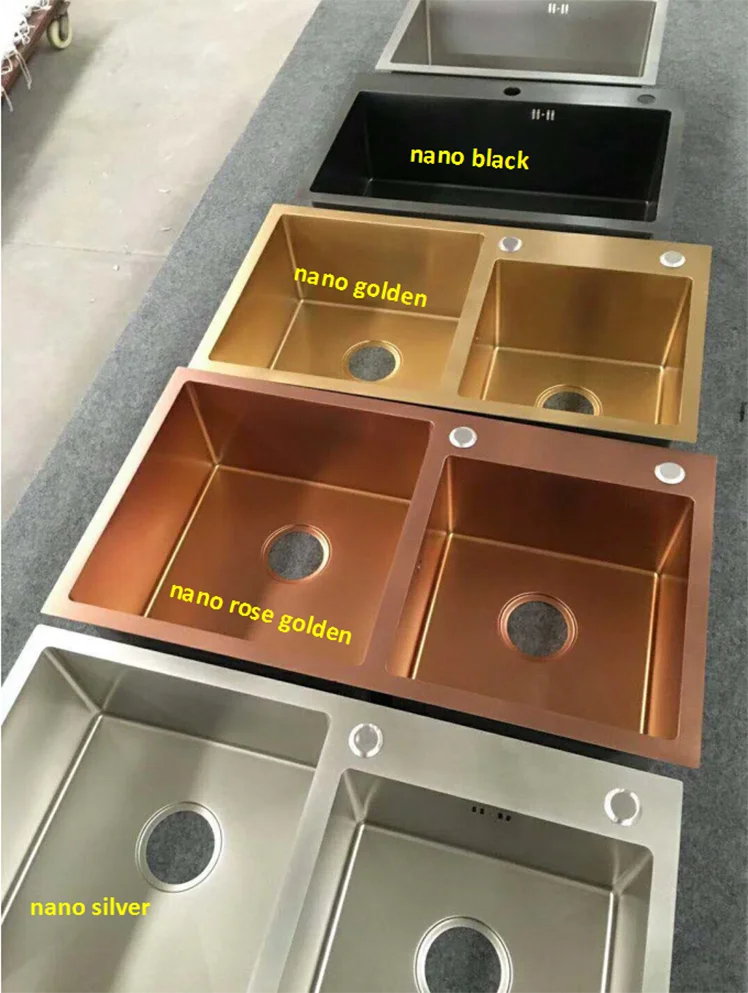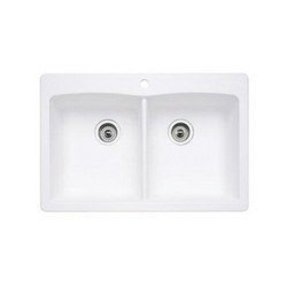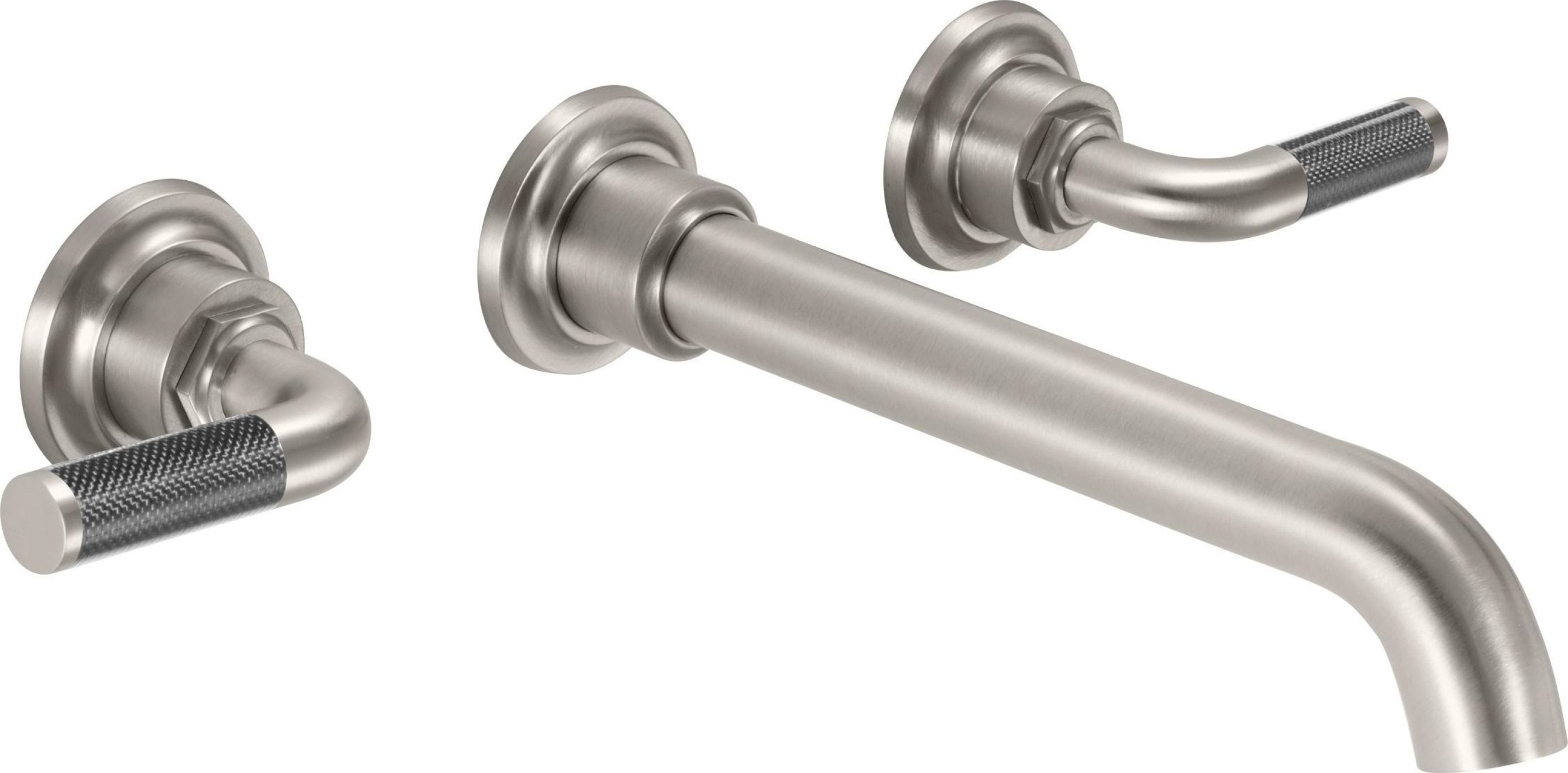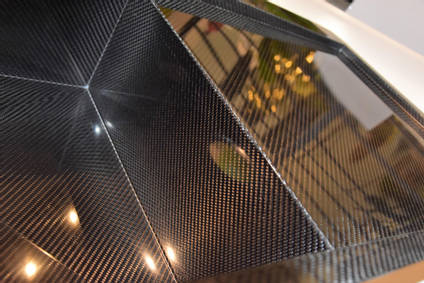Carbon Fiber Kitchen Sinks: What Sets Them Apart?
Carbon fiber kitchen sinks are a cutting-edge innovation in kitchen design, offering a sleek, modern look and exceptional functionality. Here’s a closer look at what makes these sinks unique and why they’re becoming popular in contemporary kitchens.
Innovative Material
Carbon fiber is renowned for its high strength-to-weight ratio, which means it’s incredibly strong while remaining lightweight. This advanced composite material, used extensively in aerospace and automotive industries, is now making its way into home interiors, including kitchen sinks. The result is a sink that is durable and easier to handle and install compared to traditional materials.
Unique Aesthetic
One of the most striking features of carbon fiber kitchen sinks is their appearance. The distinctive weave pattern of carbon fiber provides a modern, high-tech look that can elevate the style of any kitchen. The sleek, black carbon fiber finish complements a wide range of kitchen decors, from minimalist and industrial to more traditional styles.

Exceptional Durability
Carbon fiber sinks are incredibly resilient. They resist scratches, dents, and impacts better than traditional sink materials. This durability makes them an excellent choice for busy kitchens where the sink needs to withstand heavy use. Unlike stainless steel or porcelain, carbon fiber maintains its appearance over time, even with regular wear and tear.
Lightweight Construction
Despite their strength, carbon fiber sinks are significantly lighter than sinks made from materials like stainless steel, cast iron, or natural stone. This lightweight nature makes them easier to install and handle, reducing the strain on countertops and cabinets. It also means less hassle during transportation and installation, potentially lowering installation costs.
Thermal and Chemical Resistance
Carbon fiber is known for its excellent thermal stability and resistance to chemicals. This means that hot pots and pans won’t damage the sink and can withstand various cleaning agents without rusting or staining. This resistance to heat and chemicals ensures the sink remains functional and attractive for many years.
Eco-Friendly and Sustainable
Carbon fiber sinks are often more eco-friendly than traditional materials. Carbon fiber production has a lower environmental impact than mining and processing metals or natural stone. Additionally, the longevity of carbon fiber sinks means they don’t need to be replaced as often, reducing waste and the overall environmental footprint.

Advantages of Choosing a Carbon Fiber Kitchen Sink
Opting for a carbon fiber kitchen sink can bring numerous benefits to your home. From practical advantages to aesthetic appeal, here are some compelling reasons to consider this modern sink material.
Superior Strength and Durability
Carbon fiber is renowned for its strength, significantly higher than many traditional sink materials. This superior durability means your sink will withstand daily use without showing signs of wear and tear. It’s resistant to scratches, dents, and impacts, making it ideal for a high-traffic kitchen environment.
Lightweight and Easy Installation
One of the most notable advantages of carbon fiber sinks is their lightweight nature. This makes them easier to handle and install compared to heavier materials like cast iron or stone. The reduced weight also means less strain on your countertops and cabinetry, potentially extending their lifespan.
Modern and Sleek Design
The sleek, black finish of carbon fiber sinks provides a contemporary look that can enhance the aesthetic of any kitchen. The distinctive weave pattern of the carbon fiber material adds a touch of sophistication and modernity, making it a great choice for homeowners looking to update their kitchen’s appearance.
Heat and Chemical Resistance
Carbon fiber sinks offer excellent resistance to heat and chemicals. You can place hot pots and pans directly into the sink without worrying about damage. Additionally, these sinks can withstand various cleaning agents without corroding or staining, ensuring they remain pristine and functional for years.
Low Maintenance
Maintaining a carbon fiber sink is relatively easy. The material’s resistance to scratches and stains means it doesn’t require the frequent cleaning and polishing that other materials might. A simple wipe-down with a mild cleanser and a soft cloth is usually enough to keep the sink looking its best.
Environmental Benefits
Choosing a carbon fiber sink can be an environmentally friendly decision. The production process for carbon fiber has a lower environmental impact compared to mining and processing traditional materials. Additionally, the longevity and durability of carbon fiber sinks mean they don’t need to be replaced as often, reducing waste and the overall environmental footprint.
Comparing Carbon Fiber Sinks to Traditional Sink Materials
When choosing a kitchen sink, comparing carbon fiber sinks to traditional materials can help you make an informed decision. Here’s how carbon fiber stacks up against other common sink materials like stainless steel, porcelain, and granite.
Carbon Fiber vs. Stainless Steel
Durability: Both carbon fiber and stainless steel are highly durable, but carbon fiber has a higher strength-to-weight ratio, making it more resistant to dents and scratches.
Weight: Carbon fiber sinks are significantly lighter than stainless steel, which can make installation easier and reduce strain on countertops and cabinets.
Aesthetic: Stainless steel offers a classic, industrial look, while carbon fiber provides a modern, high-tech appearance with its distinctive weave pattern and sleek finish.
Maintenance: Both materials are low maintenance, but carbon fiber may have an edge due to its superior resistance to scratches and stains.
Carbon Fiber vs. Porcelain
Durability: Carbon fiber is more resistant to impacts and scratches compared to porcelain, which can chip or crack more easily.
Weight: Porcelain sinks are much heavier than carbon fiber sinks, making carbon fiber a more practical choice for easier installation and handling.
Aesthetic: Porcelain sinks have a traditional, elegant look, while carbon fiber sinks offer a contemporary and innovative design.
Maintenance: Porcelain requires more careful maintenance to avoid chipping and staining, whereas carbon fiber is more resilient and easier to keep clean.
Carbon Fiber vs. Granite
Durability: Both materials are highly durable, but carbon fiber is more resistant to scratches and impacts compared to granite.
Weight: Granite sinks are very heavy, making carbon fiber a lighter and more convenient option for installation and everyday use.
Aesthetic: Granite sinks offer a natural, luxurious look, while carbon fiber provides a sleek, modern aesthetic with a unique texture.
Maintenance: Granite requires sealing and careful maintenance to prevent staining, while carbon fiber is low maintenance and does not require sealing.
Carbon Fiber vs. Composite
Durability: Both carbon fiber and composite sinks are durable, but carbon fiber generally offers higher resistance to scratches and impacts.
Weight: Composite sinks can be heavy, depending on the materials used, whereas carbon fiber sinks are consistently lightweight.
Aesthetic: Composite sinks come in a variety of colors and finishes, while carbon fiber sinks offer a distinctive, high-tech look with a sleek black finish.
Maintenance: Composite sinks can stain or scratch over time, whereas carbon fiber sinks maintain their appearance with minimal maintenance.
Cost Considerations
Initial Cost: Carbon fiber sinks tend to be more expensive than some traditional materials due to the advanced technology and materials used in their production. However, the long-term durability and low maintenance can offset the initial investment.
Long-Term Value: The durability and low maintenance of carbon fiber sinks can result in long-term savings, as they don’t need to be replaced as frequently as some other materials.

How to Choose the Best Carbon Fiber Kitchen Sink
Selecting the best carbon fiber kitchen sink involves considering various factors to ensure it meets your needs and complements your kitchen design. Here are some key aspects to consider when making your choice.
Determine Your Budget
Carbon fiber kitchen sinks can be more expensive than traditional sinks, so it’s important to establish a budget before you start shopping. Consider the long-term benefits, such as durability and low maintenance, which can justify the higher initial cost. Research different brands and models to find a sink that fits within your budget without compromising on quality.
Consider the Size and Shape
The size and shape of your sink should be based on your kitchen layout and your specific needs. Measure the available space in your countertop to ensure the sink will fit properly. Common shapes include rectangular, square, and round. Consider your daily use—if you often use large pots and pans, a deeper and wider sink might be more practical.
Evaluate the Sink Configuration
Think about the configuration that will best suit your kitchen workflow. Single-bowl sinks provide more space for washing large items, while double-bowl sinks allow for multitasking, such as washing dishes in one bowl and rinsing vegetables in the other. Some sinks also come with additional features like integrated cutting boards, colanders, and drying racks.
Check for Quality and Brand Reputation
Not all carbon fiber sinks are created equal. Research brands and read reviews to ensure you’re purchasing a high-quality product. Look for sinks made with high-grade carbon fiber and check for any certifications or warranties that indicate the manufacturer’s confidence in their product. Reputable brands often offer better customer support and reliable warranties.
Consider the Finish and Design
The finish and design of the sink should complement your kitchen’s aesthetic. Carbon fiber sinks typically have a sleek black finish with a distinctive weave pattern. Consider whether you prefer a matte or glossy finish and how it will coordinate with your countertops, cabinetry, and other fixtures in the kitchen. Some sinks also come with optional features like integrated drainboards or apron fronts, which can enhance both functionality and style.

Think About Installation Requirements
Before purchasing a carbon fiber sink, consider the installation requirements and whether you have the necessary skills or will need professional help. Some sinks may require additional support due to their lightweight nature, while others may come with specific installation instructions or mounting hardware. Factor in any additional costs for installation when budgeting for your sink.
Check Compatibility with Accessories and Faucets
Ensure that the sink you choose is compatible with the accessories and faucets you plan to use. Check the dimensions and configuration of the sink to ensure it will accommodate your preferred faucet style and any additional accessories like soap dispensers or garbage disposals. Consider whether the sink has pre-drilled holes for faucet installation or if you’ll need to drill them yourself.
Read Customer Reviews and Ratings
Before making a final decision, take the time to read customer reviews and ratings for the sink you’re considering. Pay attention to feedback on durability, ease of installation, and overall satisfaction with the product. Real-world experiences from other homeowners can provide valuable insights into the quality and performance of the sink.
Consider Long-Term Maintenance
While carbon fiber sinks are known for their durability and low maintenance, it’s still essential to consider long-term care requirements. Ask about recommended cleaning products and techniques to keep the sink looking its best. Consider whether the sink’s finish is resistant to stains and scratches and whether it will require periodic polishing or sealing to maintain its appearance.
Factor in Warranty and Customer Support
Finally, consider the warranty and customer support offered by the manufacturer. A comprehensive warranty can provide peace of mind and protection against defects or damage. Look for a manufacturer that stands behind their product and offers responsive customer support in case you encounter any issues or have questions about installation or maintenance.

Installation Guide: How to Install a Carbon Fiber Kitchen Sink
Installing a carbon fiber kitchen sink is a straightforward process that can be completed with basic tools and a little know-how. Here’s a step-by-step guide to help you through the installation process.
Gather Your Tools and Materials
Before you begin, gather all the necessary tools and materials. You’ll need:
- Carbon Fiber Sink: Ensure it’s the correct size and configuration for your kitchen.
- Mounting Hardware: This may include clips, brackets, or anchors depending on the sink model.
- Plumber’s Putty or Silicone Caulk: For sealing around the edges of the sink.
- Adjustable Wrench or Channel Locks: For tightening nuts and bolts.
- Screwdriver: Flathead or Phillips, depending on the type of fasteners used.
- Safety Gear: Gloves and safety glasses to protect your hands and eyes.
Prepare the Sink and Countertop
Before installing the sink, prepare the countertop by ensuring it’s clean and free of debris. If your sink requires any additional support or bracing, now is the time to install it according to the manufacturer’s instructions. Place the sink upside down on a soft surface to prevent scratching the finish while you work.
Apply Sealant
Apply a bead of plumber’s putty or silicone caulk around the edge of the sink opening on the countertop. This will create a watertight seal between the sink and the countertop and prevent leaks.
Position the Sink
Carefully lift the sink into position and place it into the opening on the countertop. Ensure it’s centered and aligned properly before proceeding.
Secure the Sink
Once the sink is in position, secure it to the countertop using the mounting hardware provided. This may involve tightening clips, brackets, or anchors underneath the sink. Use an adjustable wrench or channel locks to tighten the nuts and bolts securely.
Connect Plumbing
If your sink includes a drain assembly, connect it to the plumbing according to the manufacturer’s instructions. This may involve attaching a tailpiece to the drain opening and connecting it to the trap and drain line.
Check for Leaks
Once the sink is securely installed and the plumbing connections are made, turn on the water and check for leaks. Inspect the connections around the drain and supply lines and tighten any fittings as needed to stop any leaks.
Seal the Edges
Finally, apply a thin bead of silicone caulk around the edges of the sink where it meets the countertop. This will provide an additional layer of protection against leaks and water damage.
Clean Up
Once the installation is complete and you’ve verified that everything is working correctly, clean up any excess caulk or putty and wipe down the sink and countertop to remove any debris.
Maintenance Tips for Keeping Your Carbon Fiber Sink in Top Condition
While carbon fiber sinks are known for their durability and low maintenance, proper care and maintenance are essential to keep them looking their best. Here are some tips to help you maintain your carbon fiber sink in top condition.
Clean Regularly
Regular cleaning is essential to prevent dirt, grime, and food debris from building up on the surface of your sink. Use a mild dish soap and warm water to clean the sink regularly, and avoid abrasive cleaners or scouring pads that can scratch the finish.
Remove Stains Promptly
If you notice any stains or discoloration on your sink, address them promptly to prevent them from becoming more difficult to remove. For stubborn stains, you can use a mild abrasive cleaner or a paste made from baking soda and water to gently scrub the surface.
Avoid Harsh Chemicals
Avoid using harsh chemicals or abrasive cleaners on your carbon fiber sink, as they can damage the finish and dull the surface. Stick to mild, non-abrasive cleaners and avoid products containing bleach or ammonia, which can cause discoloration.
Protect Against Scratches
While carbon fiber sinks are resistant to scratches, it’s still essential to take precautions to prevent damage. Avoid dropping heavy objects or sharp utensils into the sink, and use a cutting board when chopping food to protect the surface.
Dry Thoroughly
After cleaning your sink, be sure to dry it thoroughly with a soft cloth to prevent water spots and mineral deposits from forming. Pay attention to areas around the drain and faucet where water tends to collect. This will help maintain the sink’s pristine appearance and prevent any potential damage from prolonged exposure to moisture.
Use Sink Protectors
Consider using sink protectors or mats to cushion the bottom of the sink and prevent scratches from pots, pans, and utensils. These accessories can help prolong the life of your sink and keep it looking like new for longer.
Avoid Extreme Temperatures
While carbon fiber sinks are resistant to heat, it’s still best to avoid placing hot pots and pans directly onto the surface. Use trivets or hot pads to protect the sink from extreme temperatures and prevent any potential damage.
Regular Inspection
Periodically inspect your sink for any signs of damage or wear and tear. Look for scratches, chips, or cracks in the surface, as well as any loose or damaged hardware. Address any issues promptly to prevent them from worsening over time.
Prevent Hard Water Deposits
If you live in an area with hard water, you may notice mineral deposits building up on your sink over time. To prevent this, consider installing a water softener or using a vinegar solution to remove deposits regularly. You can also wipe down the sink with a mixture of water and vinegar after each use to help prevent mineral buildup.
Follow Manufacturer’s Recommendations
Finally, be sure to follow any specific care and maintenance recommendations provided by the sink manufacturer. These guidelines may include instructions for cleaning, product recommendations, and tips for prolonging the life of your sink. By following these recommendations, you can ensure that your carbon fiber sink remains in top condition for years to come.

Pin on Hand Painted Sinks

carbon sink info
Vessel Lavatory Faucet Trim Only – Carbon Fiber Handle – TO-V3002F-9 – California Faucets

Related Posts:
- Vintage Kitchen Sink With Legs
- Water Hose Connector For Kitchen Sink
- Sink Styles For Country Kitchen
- Galley Kitchen Sink Price
- Most Popular Kitchen Sinks Now
- Stainless Steel Kitchen Table With Sink
- Silicone Around Kitchen Sink
- Kitchen Sink Recommendations
- Galvanized Wash Tub Kitchen Sink
- Remove Stains From Kitchen Sink
